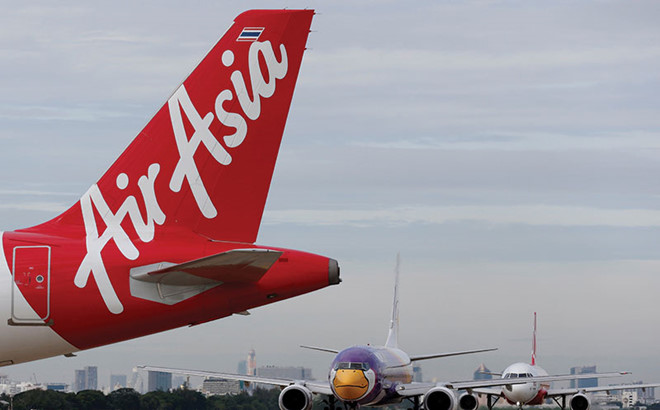Fourth time’s the charm? AirAsia’s newest attempt on Vietnam
 |
Malaysian low-cost carrier AirAsia is reportedly partnering up with two domestic firms to start an airline in Vietnam that will start operation in the beginning of 2018.
This is AirAsia’s fourth attempt in 10 years to join in the Vietnamese air transport market. The most recent attempt was in 2010 when AirAsia bought a 30 per cent stake in Vietjet, hoping to launch the first flight under the brand Vietjet AirAsia in July or August 2010. However, this attempt failed not only because the Vietnamese authorities did not allow the use of the name Vietjet AirAsia, but because of internal reasons that the leaders of the two sides did not mention then.
The previous two times was when it invested in Jetstar Pacific and when it tried to set up a new airline with Vinashin.
With the aim to become a regional airline, AirAsia has partnered up with investors in many countries in Asia to set up joint ventures. In Thailand, Thai AirAsia holds the largest market share for domestic travel at 29.5 per cent of the total transported passengers in 2016. However, the carrier has a lot less success in other countries.
In Japan, AirAsia partnered up with All Nippon Airways (ANA) to set up a joint venture in 2012. Only one year after the first flight, this joint venture failed. The reason was reported to be the difference in management style of the two sides. In June 2013, AirAsia announced withdrawing from AirAsia Japan, leaving ANA as the sole shareholder. ANA changed the name of the airline to Vanilla Air and returned AirAsia all of its planes.
In July 2014 AirAsia tried to come back to Japan by establishing a new joint venture with four other Japanese partners, namely travel company Rakuten (18 per cent), cosmetics company Noevir Holdings (9 per cent), sporting goods company Alpen (5 per cent), and investment company Octave Japan (19 per cent), to set up AirAsia Japan again. AirAsia holds 49 per cent in this venture. This new AirAsia Japan received its license to operate in October 2015.
In Indonesia, Indonesia AirAsia is having a hard time. In the third quarter of 2015, the subsidiary was the main reason for AirAsia’s $95.9 million loss, as it recorded a 14 per cent fall in revenue. The reason, according to AriAsia’s leaders, was the raft of new regulations issued by the Indonesian government on air transport.
In India, the joint venture between AirAsia and Tata, AirAsia India, also met some difficulties due to regulations of the Indian government, requiring airlines to have at least 20 planes in order to fly internationally. Moreover, the license to fly between Malaysia and India has already been given to Malaysia Airlines and Malindo Air.
In some markets, there are tight regulations on foreign ownership that limit the operation of airlines. India and Indonesia are already more open than Vietnam in this respect.
On the other hand, the success of AirAsia in Thailand was mainly due to fortunate market conditions: at the time when Thai AirAisa was launched, Thailand only had one low-cost airline, Nok Air, which had a small market share and was not very successful.
In Vietnam, there are already two low-cost airlines, namely Vietjet and Jetstar Pacific. Vietjet holds a big market share in the domestic market already.
AirAsia’s return shows that the Vietnamese air transport market has big potential but competition is fierce, too. At the moment there are four airlines in Vietnam, namely Vietnam Airlines, Vietjet Air, Jetstar Pacific, and VASCO. SkyViet and Vietstar were reported to have applied for the license last year but at the moment there has been no new announcement.
| RELATED CONTENTS: | |
| AirAsia joint venture’s prospects uncertain | |
| AirAsia plans to establish affiliate in Vietnam | |
What the stars mean:
★ Poor ★ ★ Promising ★★★ Good ★★★★ Very good ★★★★★ Exceptional
Latest News
More News
- Businesses ramp up production as year-end orders surge (December 30, 2025 | 10:05)
- Vietjet chairwoman awarded Labour Hero title (December 29, 2025 | 13:06)
- How to unlock ESG value through green innovation (December 29, 2025 | 10:03)
- AI reshapes media and advertising industry (December 29, 2025 | 08:33)
- FPT and GELEX sign deal to develop blockchain tech for global markets (December 29, 2025 | 08:29)
- Vietnam’s GDP forecast to grow by 9 per cent in 2026 (December 29, 2025 | 08:29)
- Women entrepreneurs are key to Vietnam’s economic growth (December 29, 2025 | 08:00)
- Vietnam's top 500 value-creating enterprises announced (December 27, 2025 | 08:00)
- The PAN Group shaping a better future with ESG strategy (December 26, 2025 | 09:00)
- Masan Consumer officially lists on HSX, marking the next phase of value creation (December 25, 2025 | 13:20)

















 Mobile Version
Mobile Version